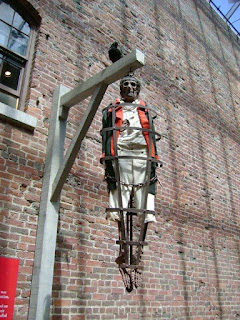Lynching of Leonard Woods Leonard Woods was an African-American man who was lynched by a mob in Pound Gap, on the border between Kentucky and Virginia
Lynching of Leonard Woods
Leonard Woods was an African-American man who was lynched by a mob in Pound Gap, on the border between Kentucky and Virginia, after they broke him out of jail in Whitesburg, Kentucky, on November 30, 1927. Woods was alleged to have killed the foreman of a mine, Herschel Deaton. A mob of people from Kentucky and Virginia took him from the jail and away from town and hanged him, and riddled his body with shots.
The killing, which became widely publicized, was the last in a long line of extrajudicial murders in the area, and, prompted by the activism of Louis Isaac Jaffe and others, resulted in the adoption of strong anti-lynching legislation in Virginia. As happens frequently with lynchings, accounts printed by white newspapers differed considerably from those found in Black newspapers. The white papers had Woods (and two young Black women) essentially jumping onto a car (driven by Deaton, who was accompanied by two friends) and then shooting Deaton, a young Virginia man from a well-to-do family who was a foreman in a Kentucky mine. The narrative in the Black papers, prompted by a report written for the NAACP, provided background information that suggested that the two Black women involved may have been prostitutes involved with Deaton and his two companions, and that Woods had some kind of relationship with one or both of the women. The lynching, then, would have served to avert a trial in which Woods's testimony might have harmed the reputation of Deaton, his friends, and his family.
Leonard Woods was a 30-year-old Black miner who lived in Jenkins, Kentucky. Jenkins was a new company town in Letcher County, built to accommodate the workers of the Consolidation Coal Company, or Consol, which was opening mines on the Cumberland Plateau in Eastern Kentucky, and had managed to get the Baltimore and Ohio Railroad to extend its line to serve its needs. Letcher County's demographics changed considerably when Consol opened up business; the coal mines attracted a large number of poor whites from all over the American South, and in addition the Black railroad workers, who built the line to Jenkins, came to work for the mines as well.
The company recruited among the Black population of the South as well, and newcomers to the country, from Eastern and Southern Europe, arrived in Jenkins as well.
As Alexander Leidholdt notes, these developments gave rise to demographic and other tension. Inside the booming mining town, wages were decent but everything, including housing, food, religion, and social life was controlled by the mining company, and the population was a mix of whites, Blacks, and recent immigrants (the number of Black Kentuckians statewide had dropped, while in Jenkins it rose), while the county itself (like the surrounding counties) consisted mostly of poor white folk, living in a relatively lawless world of high crime fueled by moonshine, turf wars over stills, and guns. ("Moonshine wars" costs 16 Letcher County deputies their lives in a four-year period.) By 1927, however, the coal boom seemed to be ending, and recent "rainstorms of biblical proportions" had made many workers in the region lose their jobs; the county was "fraught with disruption and social change.
Woods. He was then cut down, and after a woman in the crowd brought a can of gasoline, his body was burned. When the sun came up, more people came and collected souvenirs, including bullets plucked from the body. The authorities buried him at the site later that day, but hours later some Black men came from the Kentucky side and dug up the coffin, and buried it elsewhere.
Leidholdt notes that the events were very well orchestrated; the new highway and modern means of communication that enabled the murder to go so smoothly formed a stark contrast to the traditional values of the violent Cumberland community, which were in this instance confirmed, rather than threatened, by modernity. The lynching allowed the white population to exert its supposed moral superiority and its physical strength in a well-organized "sensational and theatrical spectacle".
But here also the account by Laurence Kellis sheds light on otherwise puzzling events. Why the two women were saved is hinted at in the observation in Kellis's document that one of the two friends who were with Deaton when he was shot (and most likely it was Townsend) asked, after the jail was broken into, that "his woman" not be harmed. As for the first shot that was fired at Woods, rumor had it that it was Deaton's father who shot and killed Woods. All this suggests that the lynching might well have been a carefully engineered plan to prevent a murder trial for Woods to take place, a trial in which Deaton, his father and his influential family, and the two friends might be disgraced.

_(NBY_7660).jpg)



Comments
Post a Comment